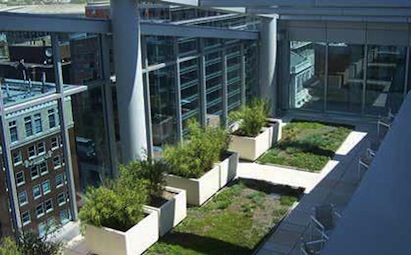The Natural Resources Defense Council has released The Green Edge: How Commercial Property Investment in Green Infrastructure Creates Value -- a first-ever illustrative and well-documented report that helps demonstrate the value of green infrastructure. It draws from available published material to capture the multitude of tangible, monetizable non-water quality and water quality benefits that green infrastructure investments (trees, rain gardens, and porous pavement, rainwater harvesting cisterns, bioswales, etc.) can unlock for the commercial real estate sector, including commercial property owners and their tenants.
By assessing common commercial real estate portfolio types, including medium-sized office buildings, midrise apartment buildings and retail centers, the new NRDC report shows that cumulative benefits to property owners can exceed the millions over the long-term, both when doing new construction and at existing developed sites.
Green infrastructure and other green building practices are increasingly becoming a quality benchmark for the private sector, because they illustrate a developer’s commitment to healthier, sustainable communities and place-making, while creating new measurable value added for property owners and tenants alike. From higher rents and property values, increased retail sales, energy savings, local financial incentives to reduced life-cycle and maintenance costs, check out The Green Edge’s blog series for a summary and visual infographics of the findings from research:.
Larry Levine, NRDC senior water attorney and author, writes about the findings of the new report here:
Paul Davis, sustainable finance fellow with NRDC’s Center for Market Innovation, shares more:
The Green Edge: A new report on the benefits of investing in natural landscapes
Alisa Valderrama, senior project finance attorney with NRDC’s Center for Market Innovation, blogs here:
The report's main findings are summarized in the infographic:


